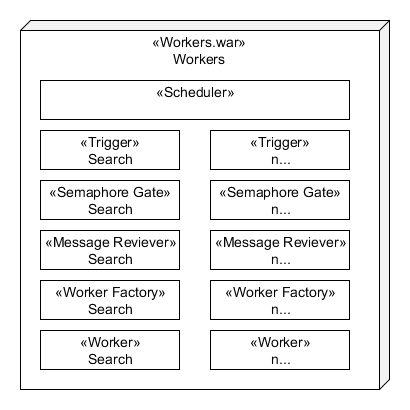| date | comment |
|---|---|
| 202109 | reviewed - no change |
| Table of Contents |
|---|
Data Sources
...
- DTO - Data Transfer Object is same object end-users see/use when making API calls.
- DBO - Database Object is a POJO that maps directly to table. For every column of the table there will be a matching field in the corresponding DBO. See Adding New Database Objects
- DAO - Data Access Object is the abstraction that translates to DTOs into DBOs directly performs all datasource CRUD.
- CRUD - Create, Read, Update, and Delete.
Workers
The workers war is composed of many workers each performing separate tasks. The following diagram shows the components of a typical worker using "search" as an example:
Scheduler
All of the works are controlled by a shared Quartz scheduler that controls the thread pool used to run each worker.
Trigger
Each worker defines its own trigger that controls the frequency which the workers runs.
Semaphore Gate
The SemaphoreGatedRunner is a re-usable class that each worker can use to control cluster wide concurrency of that worker. Each instance of the SemaphoreGatedRuner is configured for a single worker type. The worker is assigned a unique key string that is used as lock, the maximum number of concurrent worker instances that can be run across the entire worker cluster, and a timeout. A Runner is also provided (IoC) to "run" while the lock is being held.
When the scheduler fires according to the trigger, the SemaphoreGatedRunner's execute methods is called. The semaphore will generate a random number between 0 and the maximum number of workers of that type (exclusive) and concatenate that number with the worker's unique key to generate a lock string. It will then attempt to acquire a global lock on that string using the semaphore RDS table. If a lock is acquired, it will be held in a try/finally block while configured runner is executed. It will unconditionally release the lock when the Runner's run() method returns.
Locking Guarantees:
- When lock is issued, it is guaranteed to be held until released by the lock holder or the configured timeout is exceeded.
- The same lock will not be issued to multiple callers.
- Lock acquisition is non-blocking, meaning it does not wait for a lock to be acquire. In other words, the SemaphoreGatedRunner will return to the caller immediately if a lock cannot be acquired.
- When a lock is acquired a new unique token is issued to the lock holder. This token must be used to release the lock. The means if one thread is issued a lock but does not release it before the configured timeout is exceed, then the same lock can be issued to another thread but with a new token. Since the original thread's token is no longer bound to the lock, that token cannot be used to release the lock since it had been re-issued to the other caller.
Message Receiver
The message receiver is a re-usable class that is configured to pull message from an AWS SQS queue. Each instance is configured with a WorkerFactory (IoC) that is used to create workers that process messages from the queue. When a worker successfully consumes a massage it is return it to the MessageReceiver which will then delete the message from the queue.
Massage Fail-safes
Most of the message fail-safes are provided by SQS.
- A message is guaranteed to be issued to one an only one caller at a time.
- Once a message is issued it become "invisible" until it is either deleted (or "consumed") or the visibility timeout is exceeded.
- If a message is not deleted before its visibility timeout is exceed the message might be re-issued to another caller.
- Messages can only remain in the queue for a limited period of time (typically 4 days), so failed messages are eventually flushed from the queue.
A Worker
When the timer fires, a lock is acquired, and there is a message to be process a new worker instances will be generated to "consume" the message. It is the job of the worker to do actual work with a message. When the worker processes the message successful, it returns the message to the MessageReciever, which will then delete the message from the queue. When an error occurs it is the job of the worker to determine which type of error occurred. There are two types of errors:
- Recoverable errors. For example if there is a communication error, then as soon communication is restored the message can be processed successfully.
- Non-recoverable errors - For example the message is malformed. Such message will never be processable.
Important: All messages associated with non-recoverable errors should be returns to the message receiver so they can be deleted from the queue. If they are not deleted, they will build up in the queue and slow down all processing for the worker.
Recoverable errors should not be returned to the the MessageReciever so they will remain on the queue where they can be re-processed later.
